 W
WAbner Cutler & Son were cabinetmakers in Buffalo, New York who started production in the late 1820s. The firm specialised in rolltop desks and was granted seven patents related to the desk's mechanism. The company was known as 'Cutler & Son' by the 1870s and exhibited some desks at the 1876 Philadelphia Centennial Exhibition. By the early 1900s, the firm was known as the 'Cutler Desk Co.' In 1930 it was taken over by the Sikes Chair Co., also of Buffalo.
 W
WThomas Affleck (1740–1795) was an 18th-century American cabinetmaker, who specialized in furniture in the Philadelphia Chippendale style.
 W
WAndré Arbus (1903-1969) was a French furniture designer, sculptor and architect. He was a member of the Académie des Beaux-Arts, and one of his buildings is listed as an official historical monument. He was the recipient of the silver medal at the 1925 International Exhibition of Modern Decorative and Industrial Arts, and the 1934 Prix Blumenthal.
 W
WJean Avisse produced chairs, sofas, chaises and similar furniture in 18th century France.
 W
WCharles Baudouine was an American cabinetmaker and interior decorator, and was the patriarch of a major family in New York society in the late nineteenth and early twentieth centuries.
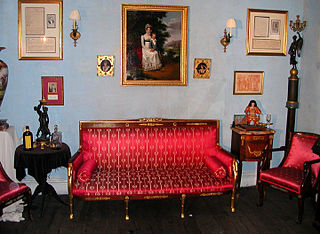 W
WPierre-Antoine Bellangé (1757–1827) was a French ébéniste (cabinetmaker) working in Paris. Bellangé held an eminent position among the representatives of the decorative arts at the beginning of the nineteenth century. He gained his master craftsman title on October 24, 1788. Among his work from this time were four chairs in mahogany described as being "of the Gothic type" that he created for Count Esterhazy.
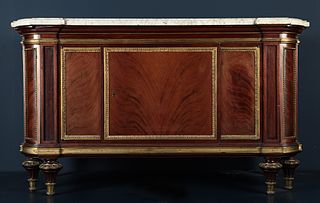 W
WGuillaume Beneman or Benneman was a prominent Parisian ébéniste, one of several of German extraction, working in the early neoclassical Louis XVI style, which was already fully developed when he arrived in Paris. Beneman arrived in Paris already trained; he was settled in the rue du Faubourg Saint-Antoine when he was received master in 1785 by royal command. He rapidly became the last of the royal cabinet-makers before the French Revolution, working under the direction of the sculptor-entrepreneur Jean Hauré, fournisseur de la cour.
 W
WGarry Knox Bennett is an American woodworker, furniture maker, metalworker and artist, known for his whimsical, inventive and unconventional uses of materials and designs in his work. His long-established workshop and studio is in Oakland, California.
 W
WMartin Carlin was a Parisian ébéniste (cabinet-maker), born at Freiburg, who was received as Master Ébéniste at Paris on 30 July 1766. Renowned for his "graceful furniture mounted with Sèvres porcelain", Carlin fed into the luxury market of eighteenth-century decorative arts, where porcelain-fitted furniture was considered among "the most exquisite furnishings" within the transitional and neoclassical styles. Carlin's furniture was popular amongst the main great dealers, including Poirier, Daguerre, and Darnault, who sold his furniture to Marie Antoinette and many amongst the social elite class. He died on 6 March 1785.
 W
WEliphalet Chapin (1741–1807) was a cabinetmaker and furniture maker in East Windsor, Connecticut in the late 18th century. His style of furniture design is regarded as one of the most elegant of its time.
 W
WCharles Cressent (1685–1768) was a French furniture-maker, sculptor and fondeur-ciseleur of the régence style. As the second son of François Cressent, sculpteur du roi, and grandson of Charles Cressent, a furniture-maker of Amiens, who also became a sculptor, he inherited the tastes and aptitudes which were likely to make a finished designer and craftsman. Even more important perhaps was the fact that he was a pupil of André Charles Boulle. Trained in such surroundings, it is not surprising that he should have reached a degree of achievement which has to a great extent justified the claim that he was the best decorative artist of the 18th century. Cressent's distinction is closely connected with the regency, but his earlier work had affinities with the school of Boulle, while his later pieces were full of originality.
 W
WMathieu Criaerd (1689–1776) was the most prominent of a large family of cabinetmakers (ébénistes), apparently of Flemish ancestry, who were working in Paris during the 18th century. He became a master in the Corporation des Menuisiers-Ébénistes 29 July 1738 and set up his workshop in the rue Traversière-Saint-Antoine, in the heart of the furniture-making district of Paris, using the stamp M CRIAERD.
 W
WHenry Dasson (1825–1896) was a renowned nineteenth century Parisian maker of gilt-bronze mounted furniture. Unlike other cabinetmakers of the time Dasson began his career as a bronze sculptor, and consequently one characteristic of his work is the quality of his bronze and more precisely of the chiselling.
 W
WLouis Delanois (1731–1792) was a Parisian menuisier who specialized in seat furniture in the late Rococo taste and an advanced neoclassical taste. Among his notable patrons were mme du Barry, the comte d'Artois, brother of the king, Philippe, duc de Chartres and the duc de Condé. Foreigners like the king of Poland and the duke of Dorset also bought furniture from Delanois, whose manuscript account book survives in the Archives de la Seine. His attempts, after selling off his furniture business in 1777, to extend his business into the timber trade and property speculation, however, resulted in bankruptcy by 1789.
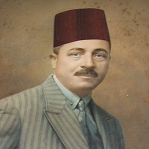 W
WThe Furniture industry was developed many times in Egypt from the old ancient to now. During 1st 30 years of the 20th century, there was a great furniture developments in Europe from transitional furniture to Modern tastes ("Modernism"). Egyptian were influenced by these movements which was a mix of many different styles. Fahim ElGindy was the leader of this development in Egypt. He demonstrated his art in Europe and Egypt. He established the furniture industry in Damietta.
 W
WMichael Felke was a German furniture manufacturer.
 W
WWilliam France Jr. was a cabinetmaker and upholsterer in 18th century London and a member of the well known France family who held the Royal Warrant for over half a century. He was the nephew of William France Sr. and younger brother of Edward France, the former being cabinetmaker to the Royal Household. He was born in 1759 and died in 1838 in Boulogne, France. He was made a Freeman of Lancaster in 1785–86.
 W
WAntoine-Robert Gaudreau was a Parisian ébéniste who was appointed Ébéniste du Roi and was the principal supplier of furniture for the royal châteaux during the early years of Louis XV's reign. He is largely known through the copious documentation of the Garde-Meuble de la Couronne; he entered the service of the Garde-Meuble in 1726. However, since his career was spent before the practice of stamping Paris-made furniture began (1751), no stamped piece by Gaudreau exists and few identifications have been made, with the exception of royal pieces that were so ambitious and distinctive that they can be recognized from their meticulous inventory descriptions.
 W
WAlexander Grabovetskiy is a Russian-American Master wood carver.
 W
WJean-François Hache (1730-1796) was a French ébéniste.
 W
WMichelle Holzapfel is an American woodturner and a participant in the American Craft movement. Michelle Holzapfel has five decades of experience turning and carving native hardwoods in Marlboro, Vermont, where she has lived her adult life. Holzapfel fits the definitions of both Studio artist and Material movement artist. A product of the revolutionary back-to-the-earth movement of 1960s and 1970s, she attributes the expressiveness of her turned and carved forms to the idealism of those years. Raised in rural Rhode Island, she has worked alone in her Vermont studio—shared only with her husband, the furniture maker and educator David Holzapfel—since 1976. Her wood pieces which feature intricate carvings have been exhibited in museums and galleries in the U.S., Australia and Europe. Publications featuring her work include but are not limited to House Beautiful, American Craft, Woodworking, and Fine Woodworking.
 W
WFrançois-Honoré-Georges Jacob-Desmalter (1770–1841) oversaw one of the most successful and influential furniture workshops in Paris, from 1796 to 1825. The son of Georges Jacob, an outstanding chairmaker who worked in the Louis XVI style and Directoire styles of the earlier phase of Neoclassicism and executed many royal commissions, Jacob-Desmalter, in partnership with his older brother, assumed the family workshop in 1796. Freed from the Parisian guild restrictions of the Ancien Régime, the workshop was now able to produce veneered case-pieces (ébénisterie) in addition to turned and carved seat furniture (menuiserie). When his brother died, Jacob-Desmalter drew his father from retirement and began to develop one of the largest furniture workshops in Napoleonic Paris.
 W
WGeorges Jacob was one of the two most prominent Parisian master menuisiers. He produced carved, painted and gilded beds and seat furniture and upholstery work for the French royal châteaux, in the Neoclassical style that is associated with Louis XVI furniture.
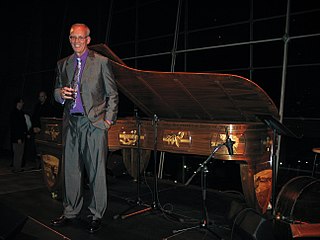 W
WSilas Kopf is an American furniture maker specializing in the art of marquetry. Kopf graduated from Princeton University in 1972 with a degree in architecture and soon began designing and making furniture. In 1988, he received a Craftsman's Fellowship from the National Endowment for the Arts, and used the opportunity to study traditional marquetry technique at the École Boulle, an institute of interior architecture and design, in Paris. His major projects include several pianos commissioned by Steinway & Sons and benches, desks, and cabinets for private collections and museums. His designs frequently incorporate floral depictions, other images from nature, and trompe l'oeil concepts. He first became interested in marquetry because he hoped for an alternative, less consumerist lifestyle.
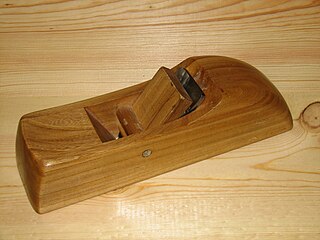 W
WJames Krenov was a woodworker and studio furnituremaker.
 W
WRoger Vandercruse Lacroix (1728–1799), often known as Roger Vandercruse, was a Parisian ébéniste whose highly refined furniture spans the rococo and the early neoclassical styles. According to Salverte, he "is counted among the great ebenistes of his generation ."
 W
WJean-Pierre Latz was one of the handful of truly outstanding cabinetmakers (ébénistes) working in Paris in the mid-18th century. Like several of his peers in the French capital, he was of German origin. His furniture is in a fully developed rococo style, employing boldly sculptural gilt-bronze mounts complementing marquetry motifs of flowers and leafy sprays, in figured tropical veneers like tulipwood, amarante, purpleheart and rosewood, often featuring the distinctive end-grain cuts. He also produced lacquered pieces, most famously the slant-front desk in the collection of Stavros Niarchos, Paris.
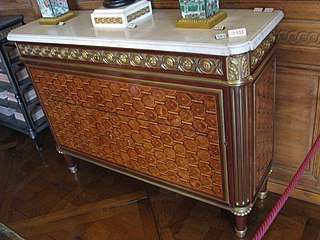 W
WJean-François Leleu was a leading French furniture-maker (ébéniste) of the eighteenth century.
 W
WFrançois Linke (1855–1946) was a leading Parisian ébéniste of the late 19th and early 20th centuries.
 W
WPierre Macret (1727–1796) was a well-known Parisian cabinetmaker (ébéniste). At the death of the widow of Jean-Pierre Latz in December 1756, he received Latz' court warrant as marchand-ébéniste privilégié du Roi suivant la Cour,, a brevet that exempted him from the stringent regulations of the Paris guild. In 1758 he was belatedly admitted maître-ébéniste by the guild, which henceforth required him to stamp his production. Numerous pieces bearing Macret's poinçon survive.
 W
WLouis-Jean-Sylvestre Majorelle, usually known simply as Louis Majorelle, was a French decorator and furniture designer who manufactured his own designs, in the French tradition of the ébéniste. He was one of the outstanding designers of furniture in the Art Nouveau style, and after 1901 formally served as one of the vice-presidents of the École de Nancy.
 W
WSam Maloof was a furniture designer and woodworker, the first craftsman to receive a MacArthur fellowship. Maloof's work is in the collections of several major American museums, including the Metropolitan Museum of Art, the Los Angeles County Museum of Art, the Philadelphia Museum of Art, and the Smithsonian American Art Museum. He was described by The New York Times as "a central figure in the postwar American crafts movement".
 W
WMarket Square is a furniture showroom complex in High Point, North Carolina, owned by International Market Centers which is the largest building in North Carolina on the National Register of Historic Places (NRHP), and the sixth largest in the United States. Known also as Tomlinson Chair Manufacturing Company Complex, it was listed on the NRHP under that name. The former manufacturing complex includes the oldest factory building in the city, and its renovation has been credited with making High Point a successful furniture exhibition center. A 16-story addition in 1990 is one of the city's tallest buildings.
 W
WJoseph Meeks was a furniture maker in New York City who founded what would become a large firm that produced good quality furniture from 1797 to 1869.
 W
WPhyllis Morris was an American furniture designer known for her colorful persona, her outspokenness on decorating and her distinctive furniture and interior designs, especially her large and highly decorative beds. She was often referred to by the media as the "designer to the stars." By the time of her death, Morris had left a mark in the world of interior design in each of the four decades since the founding of her company Phyllis Morris Originals in 1953.
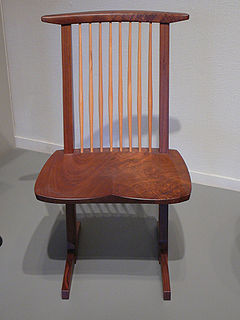 W
WGeorge Katsutoshi Nakashima was an American woodworker, architect, and furniture maker who was one of the leading innovators of 20th century furniture design and a father of the American craft movement. In 1983, he accepted the Order of the Sacred Treasure, an honor bestowed by the Emperor of Japan and the Japanese government.
 W
WWallace Nutting was a U.S. minister, photographer, artist, and antiquarian, who is most famous for his landscape photos of New England. He also was an accomplished author, lecturer, furniture maker, antiques expert and collector. His atmospheric photographs helped spur the Colonial Revival style.
 W
WJean-François Oeben, or Johann Franz Oeben was a German ébéniste (cabinetmaker) whose career was spent in Paris. He was the maternal grandfather of the painter Eugène Delacroix.
 W
WDaniel Pabst was a German-born American cabinetmaker of the Victorian Era. He is credited with some of the most extraordinary custom interiors and hand-crafted furniture in the United States. Sometimes working in collaboration with architect Frank Furness (1839–1912), he made pieces in the Renaissance Revival, Neo-Grec, Modern Gothic, and Colonial Revival styles. Examples of his work are in the collections of the Metropolitan Museum of Art, the Philadelphia Museum of Art, the Art Institute of Chicago, and the Victoria and Albert Museum in London.
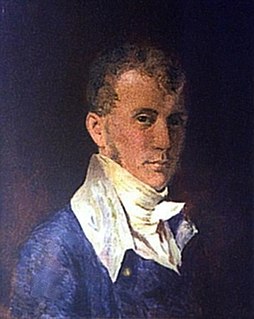 W
WDuncan Phyfe was one of nineteenth-century America's leading cabinetmakers.
 W
WJean-Henri Riesener was a famous German ébéniste (cabinetmaker), working in Paris, whose work exemplified the early neoclassical "Louis XVI style".
 W
WGerrit Thomas Rietveld was a Dutch furniture designer and architect. One of the principal members of the Dutch artistic movement called De Stijl, Rietveld is famous for his Red and Blue Chair and for the Rietveld Schröder House, which is a UNESCO World Heritage Site.
 W
WBernard II van Risamburgh, sometimes Risen Burgh was a Parisian ébéniste of Dutch and French extraction, one of the outstanding cabinetmakers working in the Rococo style. "Bernard II's furniture is brilliant in almost every respect. His carcasses are beautifully shaped, his mounts and marquetry are always in complete balance even when extremely elaborate, and there is a logic to his works that allows the eye to comprehend them effortlessly," wrote Ted Dell.
 W
WAbraham Roentgen was a German Ébéniste (cabinetmaker).
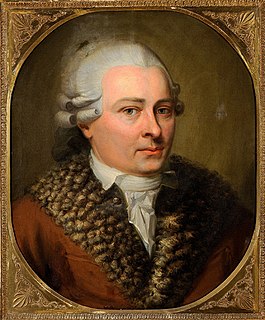 W
WDavid Roentgen, was a famous German cabinetmaker of the eighteenth century, famed throughout Europe for his marquetry and his secret drawers and poes and mechanical fittings. His work embraces the late Rococo and the Neoclassical styles.
 W
WDavid Lincoln Rowland was an American industrial designer noted for inventing the 40/4 Chair. The chair was the first compactly stackable chair invented, and is able to stack 40 chairs 4 feet (120 cm) high.
 W
WRoycroft was a reformist community of craft workers and artists which formed part of the Arts and Crafts movement in the United States. Elbert Hubbard founded the community in 1895, in the village of East Aurora, New York, near Buffalo. Participants were known as Roycrofters. The work and philosophy of the group, often referred to as the Roycroft movement, had a strong influence on the development of American architecture and design in the early 20th century.
 W
WFrancesco Scibec, called Scibec da Carpi, was a 16th-century Italian furniture maker from Carpi near Modena. He worked for the French royal court amongst a group of artists now called the first school of Fontainebleau.
 W
WAdrien Segal is an artist, furniture maker, and sculptor who uses data to inform her artwork. She is currently an adjunct professor of Furniture Design at the California College of the Arts and a practicing artist studio furniture maker.
 W
WJanice Smith is a furniture maker and educator based in Philadelphia, Pennsylvania.
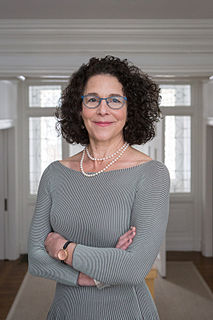 W
WRosanne Somerson is an American-born woodworker, furniture designer/maker, educator, and current President of Rhode Island School of Design (RISD). An artist connected with the early years of the Studio Furniture, her work and career have been influential to the field.
 W
WJames Gilbert Sterchi was an American businessman, best known as the cofounder and head of the furniture wholesaler, Sterchi Brothers Furniture Company. At its height, Sterchi Brothers was the world's largest furniture store chain, with sixty-five stores across the southeastern United States and a worldwide customer base. In 1946, the company became the first Knoxville-based firm to be listed on the New York Stock Exchange. The company's ten-story headquarters, now called Sterchi Lofts, stands prominently along Knoxville's skyline, and Sterchi's home in northern Knoxville, Stratford Mansion, is listed on the National Register of Historic Places.
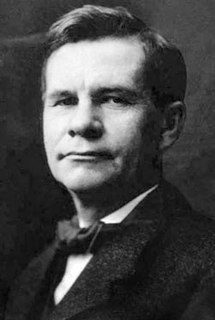 W
WGustav Stickley was an American furniture manufacturer, design leader, publisher, and a leading voice in the American Arts and Crafts movement. Stickley's design philosophy was a major influence on American Craftsman architecture.
 W
WFrançois-Gaspard Teuné was a Parisian ébéniste who was made master 19 March 1766. His stamped works are in the Neoclassical style, sometimes, as in the marquetry commode at the Walters Art Museum (illustration) reflecting vestiges of the Rococo in stiffened cabriole legs and the softened transitions between planes. He was one of a number of Parisian furniture makers of German families. He had premises in rue Traversière-Saint-Antoine and then in rue de Charonne. He disappears from the documents at the start of the Revolution.
 W
WMichael Thonet was a German-Austrian cabinet maker, known for the invention of bentwood furniture.
 W
WEugène Vallin was a [French furniture designer and manufacturer, as well as an architect.
 W
WJ.B. Van Sciver Furniture Co. was a furniture company in Camden, New Jersey, founded in 1881 by Joseph Bishop Van Sciver and later run by his sons, Joseph Bishop Van Sciver Jr., Lloyd Van Sciver, and Russell Van Sciver. The company also opened stores in Allentown, Pennsylvania and Trenton, New Jersey.
 W
WWilliam Vile was an English cabinetmaker.
 W
WJoseph Walsh is a self-taught Irish furniture maker, artist and designer. He was born in County Cork and founded his studio and workshop in 1999. Walsh's creative approach reflects his appreciation of nature and also his desire to engage the user with visual and tactile forms.
 W
WAdam Weisweiler was a pre-eminent French master cabinetmaker (ébéniste) in the Louis XVI period, working in Paris.